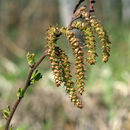en
names in breadcrumbs


Many Native American tribes used different parts of Comptonia peregrina variously: as an incense for ritual ceremonies; for medicinal purposes; as a stimulant or tonic; as a food seasoning; and as a poison (D. A. Moerman 1986).
Comptonia peregrina is a species of flowering plant in the family Myricaceae. It is the only extant (living) species in the genus Comptonia,[4] although a number of extinct species are placed in the genus. Comptonia peregrina is native to eastern North America, from southern Quebec, east to Nova Scotia, south to the extreme north of Georgia, and west to Minnesota. The common name is sweetfern or sweet-fern (although it is not a fern), or in Quebec, comptonie voyageuse.[2]
The genus Comptonia is named in honor of Rev. Henry Compton (1632-1713), bishop of Oxford.
The species name peregrina literally means one that travels. Compare the plant's Quebec French name, comptonie voyageuse: "traveling comptonia."
Comptonia peregrina is a deciduous shrub, growing to 1.5 m (4.9 ft) tall. The leaves of the plant are linear to lanceolate, 3–15 cm (1.2–5.9 in) long and 0.3–3 cm (0.1–1.2 in) broad, with a lobed margin; they give off a sweet odor, especially when crushed. Plants are monoecious with separate unisexual flowers. The staminate flowers grow in clusters at the ends of branches, and are up to 5 cm (2.0 in) long. The pistillate flowers are only 5 mm (0.2 in), but elongate when the fruits form, reaching 5 cm (2.0 in).[2]
The species was first described, as Liquidambar peregrina, by Carl Linnaeus in 1753, in the second volume of Species Plantarum. Further on in the same volume, he described Myrica aspleniifolia as a different species (with the epithet spelt asplenifolia[note 1]). In 1763, he changed his mind concerning Myrica aspleniifolia, and it became Liquidambar aspleniifolia, and so in the same genus as Liquidambar peregrina.[5]
In 1789, Charles Louis L'Héritier placed Linnaeus's original Myrica aspleniifolia in his new genus Comptonia.[6]
In 1894, John M. Coulter transferred Linnaeus's Liquidambar peregrina to Comptonia, and treated Linnaeus's Myrica aspleniifolia as a synonym.[5] Comptonia peregrina is now the only extant (living) species in the genus.[4]
Comptonia peregrina is native to eastern North America, from Ontario and Quebec in the north, east to Nova Scotia, to Georgia in the south, and west to Minnesota.[1] It tends to grow on dry sandy sites, and is associated with pine stands.[2]
Comptonia peregrina is used as a food plant by the larvae of some Lepidoptera species, including Bucculatrix paroptila, grey pug, setaceous Hebrew character, Io moth, and several Coleophora case-bearers: C. comptoniella, C. peregrinaevorella (which feeds exclusively on Comptonia), C. persimplexella, C. pruniella and C. serratella. It is also a non-legume nitrogen fixer.
The plant produces a bristly burr that contains 1 to 4 edible nutlets.[7]
The aromatic leaves (fresh or dried) are also used to make a tea. The Canadian author Catharine Parr Traill includes it in her book The Female Emigrant's Guide in a list of substitutes for China tea. "When boiled," she notes, "it has a slightly resinous taste, with a bitter flavour, that is not very unpleasant." Mistaking it, like others, for a fern, she says that it is in high repute "among the Yankee and old Canadian housewifes (sic)."[8] Tea made from the plant has been said to treat the effects of poison ivy when applied to the affected area.[9] The plant has also been used as a seasoning.[10]
Comptonia peregrina is a species of flowering plant in the family Myricaceae. It is the only extant (living) species in the genus Comptonia, although a number of extinct species are placed in the genus. Comptonia peregrina is native to eastern North America, from southern Quebec, east to Nova Scotia, south to the extreme north of Georgia, and west to Minnesota. The common name is sweetfern or sweet-fern (although it is not a fern), or in Quebec, comptonie voyageuse.